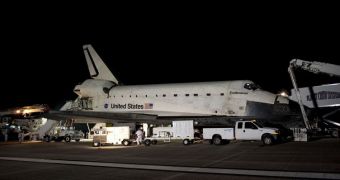Officials at NASA say that the space shuttle Endeavour will soon begin undergoing the necessary preparations for converting it from a flight-ready spacecraft to a museum exhibit. There are numerous toxic chemicals on the orbiter, that need to be removed before it can be displayed to the public.
As announced earlier this year, this shuttle will go to the California Science Center, in Los Angeles. Its sister, Discovery, will soon be delivered to the Smithsonian National Air and Space Museum, in Washington DC.
Atlantis, which has yet to perform her final flight, will be displayed at the Kennedy Space Center (KSC) Visitor Complex, once it returns from STS-135 and is itself sanitized. All shuttles could be accommodated at their respective locations by the end of the year, or in early 2012.
“I imagine millions of people, hopefully millions of people a year, will get to enjoy getting up close to the space shuttle,” NASA astronaut Mark Kelly from orbit yesterday, shortly before landing.
“I think we all look forward to visiting it in the science museum there. But it is a bittersweet moment. It's been a great spacecraft,” he added, quoted by Space. Kelly was the STS-134 commander.
Endeavour returned home after a 16-day stay in space yesterday, June 1. It landed at the KSC in the wee hours of the morning, as Atlantis was still being rolled out to the Launch Pad 39A facility.
During its last mission, six astronauts delivered an advanced particle detector to the International Space Station. The $2 billion Alpha Magnetic Spectrometer (AMS) will analyze high-energy cosmic rays for years to come.
This was Endeavour's 25th flight. It is the youngest of the three-orbiter shuttle fleet, having flown for the first time back in 1992. It was created as a replacement for the shuttle Challenger, which blew up 73 seconds after liftoff, in 1986.
NASA officials say that the shuttle could make its way to the CCC by early spring 2012, if the decommissioning process goes according to plan. Endeavour is now stored in the KSC Orbiter Processing Facility 1 (OPF-1).
Some of the most intricate components, such as the nose thruster system and the two large engines at the back of the shuttle, will be sent to other NASA facilities for decontamination. The OPF-1 does not have the necessary technology to handle that itself.
“This is for 'museum-clean.' They're completely flushing out the system. Twenty years from now, we don't want some sort of piping to degrade and suddenly drip hydrazine on people,” KSC spokesman Allard Beutel says.
At this point, NASA is considering turning the delivery of Endeavour to California into a show, in the sense that the Shuttle Carrier Aircraft which will move the orbiter will have to stop several times along the way. On these occasions, the public might be given a chance to see the shuttle, Space informs.

 14 DAY TRIAL //
14 DAY TRIAL //